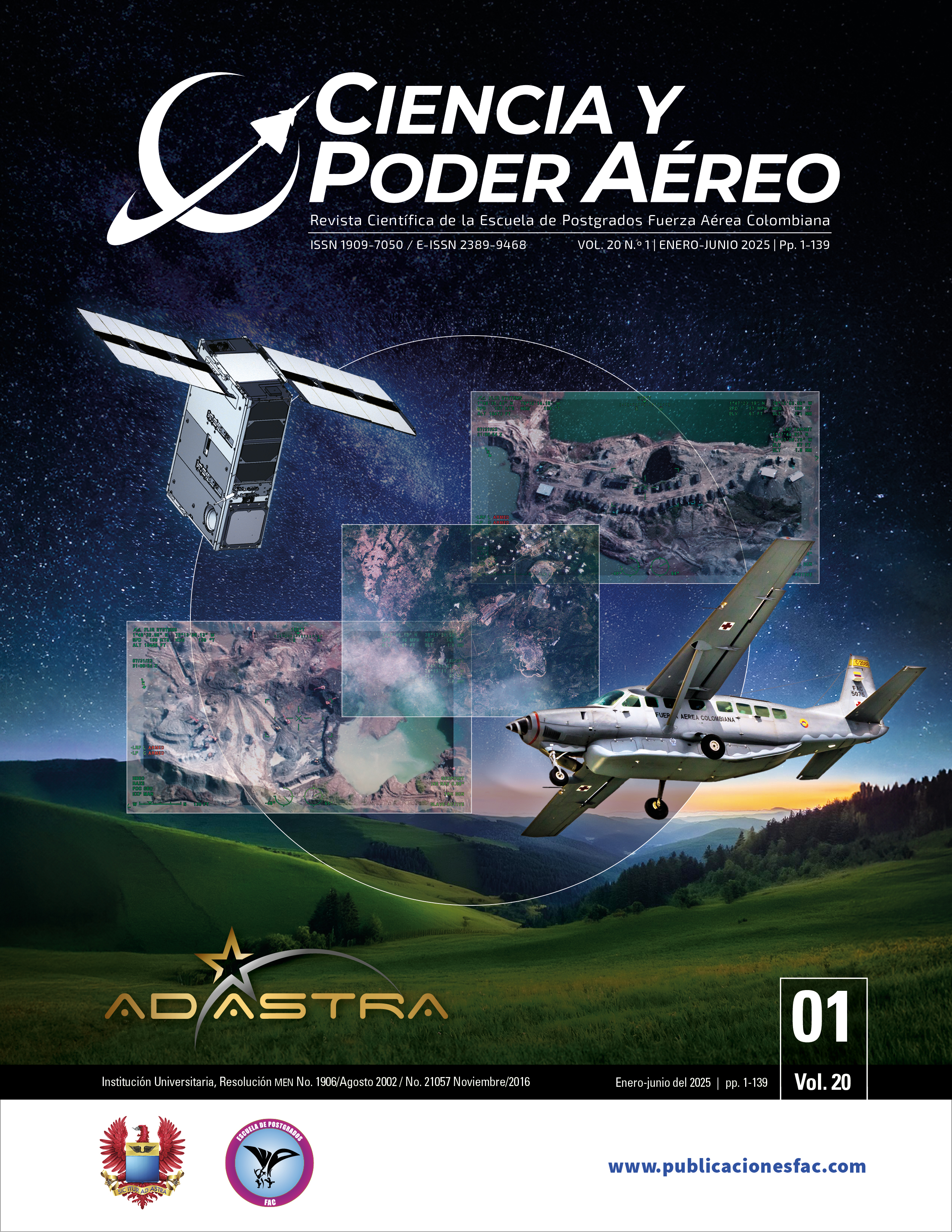Implementation of space doctrine: Challenges in conceiving space as an operational domain
DOI:
https://doi.org/10.18667/cienciaypoderaereo.814Keywords:
doctrine, military, space domineAbstract
This exploratory article focuses its analysis on Nisser's theoretical model of doctrinal implementation based on the triad (authority, culture, and credibility), describing within this context the possible challenges that various Air Forces in the region may face, which They seek to implement space as an operational domain in their doctrine. Furthermore, it is addressed how the aforementioned space doctrine is in many cases seen as a tool of change or transformation in its operational context, observing that there is certain standardization through common organizational structures such as Space Operations Centers, which not only direct their efforts to a spatial command and control and regional interoperability, but to the pragmatism that said structure contributes to the process of implementation of the doctrine.
Downloads
References
Avant, Deborha (1993). “The Institutional Sources of Military Doctrine: Hegemons in Peripheral Wars,” International Studies Quarterly 37, no. 4, 923. DOI: https://doi.org/10.2307/2600839
Bergamaschi, J. (2018). Estrategia, Política y Doctrina Aeroespacial Para Un País En Desarrollo. Airpower Journal, 3–9.
Carrasco, Juan. (2001). Doctrina aeroespacial, necesidades y retos para el ejército del aire. Boletín de Información, (269), 2.
Domenech, D. G., & Velasco, F. Y. (1993). Los estudios estratégicos en el ámbito del Ejército del Aire. Cuadernos de estrategia, (66), 113-139.
Finkel, M., & Tlamim, M. (2011). On flexibility: recovery from technological and doctrinal surprise on the battlefield. Stanford University Press. DOI: https://doi.org/10.1515/9780804777155
Jennings, F. W. (2002). La Nueva Doctrina Demanda Cambios en la Fuerza Aeroespacial. Aerospace Power Journal, 4–6.
Marcus, Raphael (2018). Israel’s Long War with Hezbollah: Military Innovation and Adaptation under Fire (Washington, DC: Georgetown University Press), 100. DOI: https://doi.org/10.2307/j.ctv75db9b
Matthews, Matt (2012). We Were Caught Unprepared: The 2006 Hezbollah-Israeli War (Fort Leavenworth: Combat Studies Institute), 62.
Nisser, John (2021). Implementing military doctrine: A theoretical model, Comparative Strategy, 40:3, 305-314. DOI: https://doi.org/10.1080/01495933.2021.1912514
López, C. D. V. (2021). La industria española de defensa ante los nuevos conflictos: capacidades a aportar. RESI: Revista de estudios en seguridad internacional, 7(2), 63-81. DOI: https://doi.org/10.18847/1.14.4
Ramos, L. F. R. (2003). Reflexiones sobre la doctrina. Boletín de Información, (278), 47-60.
Santé Abal, J. M. (2017). La doctrina aeroespacial y la estrategia de seguridad aeroespacial. In Hacia una estrategia de seguridad aeroespacial (pp. 105–146).
Tamame Camarero, J. (2002). El poder aeroespacial ya es un hecho. Arbor, CLXXI(674), 217–229. DOI: https://doi.org/10.3989/arbor.2002.i674.1029
Widén, J., & Olsén, T. (2020). Doktrindilemmat: Vad är problemet och hur kan det lösas?. Kungl Krigsvetenskapsakademiens Handlingar Och Tidskrift, (1), 44-57.
AJP, N. S. (2016). 3.3 Allied Joint Doctrine For Air And Space Operations. Edition B Version, 1(8).
Downloads
Published
Issue
Section
License
Copyright (c) 2024 Escuela de Postgrados de la Fuerza Aérea Colombiana

This work is licensed under a Creative Commons Attribution 4.0 International License.
Assignment of Copyrights
Authors assign Ciencia y Poder Aéreo journal the exclusive rights (reproduction, distribution, public communication, and transformation) to exploit and commercialize their work, in whole or in part, in all the formats and modalities of present or future exploitation, in all languages, throughout the life of the work and throughout the world.
All contents published in Ciencia y Poder Aéreo journal are licensed under a Creative Commons Attribution 4.0 International License, whose complete information is available at http://creativecommons.org/licenses/by/4.0/
Under the terms of this license, users are free to download, print, extract, archive, distribute and publicly communicate the content of articles, provided that proper credit is granted to authors and Ciencia y Poder Aéreo, scientific journal of the Graduate School of the Colombian Air Force. Except when otherwise indicated, this site and its contents are licensed under a Creative Commons Attribution 4.0 International License.
For other uses not considered under this license it is required to contact the Director or the Editor of the journal at the e-mail address cienciaypoderaereo1@gmail.com.
The Graduate School of the Colombian Air Force and this publication are not responsible for the concepts expressed in the articles, including the metadata or the affiliation stated by authors. This is the full responsibility of the authors.






















